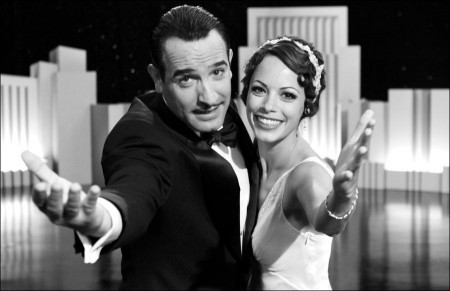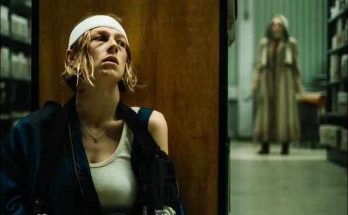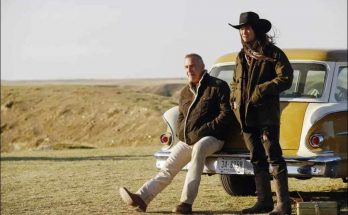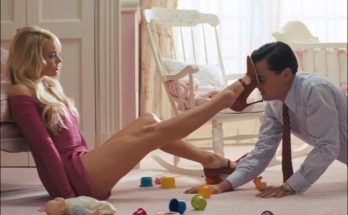“The Artist” began filming in Los Angeles in November 2010, and shot for 35 days. The stylistic approach of THE ARTIST necessitated the use of some special equipment and techniques, in part to accommodate the 1.33 format. For Schiffman, the effort was well worth it. “It’s not by chance that cinema was invented with this format. It allows beautiful close-ups; it allows you to compose the picture differently, to have diagonals, to create perspectives. It was heaven! It is a bit more complicated to light because you have to place the projectors a lot higher. I understood why the studios of the time were 8 meters high. So I had to learn how to light with very tall sets, and more powerful sources. And I used a lot of old projectors from the ’50s and ’60s.”
Paradoxically, perhaps, modern black and white film stock turned out to be too precise and sharp-looking for THE ARTIST. As a result, Schiffman used 500 ASA color film that could impart a grainer look, and used unusual filters to achieve the diffused whites and underplayed blacks.
The cast of THE ARTIST found themselves in an unusual situation when the cameras began to roll. As Cromwell describes it, “As an actor, you have to trust that something you can’t see — namely your own face — is expressing all that you feel and need to communicate to tell the story.” He notes that there were technical differences as well, because they were shooting at 28 frames per second versus the more common 24 frames per second. “You have to adjust to the slightly faster film speed by sustaining the moment a fraction longer to allow the audience to ‘read’ the intention and adjust their perception.”
“For the actors, shooting this film was a very particular exercise,” Hazanavicius acknowledges. “For most actors, the voice is a great asset. Suddenly, they had to make do without it. Text is an essential aid to convey feelings, but here, everything had to be conveyed visually, with no help from words, breath, pauses, tone, all the variations actors normally use. I think that what they had to do was very difficult, even more so than usual.”
As George Valentin, Dujardin travelled an emotional landscape that went from light to dark and back again. “It was exciting to start with this character who is always showing off, in front of the camera, with his fans, with his wife, but then slides gradually into darker waters. At first I was nervous about those more serious scenes, for which I had no lines to hold on to. But I discovered that silent film was almost an advantage. You just have to think of the feeling for it to show. No lines come to pollute it. It doesn’t take much – a gaze, an eyelash flutter – for the emotion to be vivid.”
He trusted Hazanavicius to give him the guidance he needed, without imposing too much. “Michel puts you, with great sensitivity and without any wickedness, on the track of these darker feelings, painful emotions. He lets you go and find them yourself, though he no hesitation in asking you to go even further. I appreciate very much that he leaves you get on with your work as an actor.”
Making a silent did bring a major, very welcome advantage during filming: silence was not required on the set. They actors could speak their lines to one another, and Hazanavicius could, and did, speak to them as they were filming. Says Béjo, “Without cutting, Michel could give us indications to make us go from one emotion to another. It was interesting and rewarding, because it made you search for something else in the heat of the moment.”
Hazanavicius also played music on set, ranging from classic Hollywood scores and early themes composed by Bource to individual songs he knew would resonate with the players. “It made our lives easier because it allowed us to overplay with the voice and not be embarrassed; it carried us wonderfully,” says Béjo. “Certain pieces of music will carry you away immediately if you listen to them just before an emotional scene. Michel always knew which music to play. For the scene where I get off the bus and arrive at the studio for an audition he played ‘Day for Night.’ It’s so cheerful that I was immediately transported: it gave me wings!”
Dujardin and Béjo may have had few lines to learn, but there was one thing they had to study: dance, specifically tap dance. Both spent months taking dance and tap lessons, and then spent a few weeks working on choreography together. When they day came to film the tap dance number that brings THE ARTIST to its jubilant conclusion, they were ready. Remembers Dujardin, “We knew that Michel would cut as little as possible, which made it more exciting. We had to remember our steps and at the same time maintain expression, grace and feeling. Of course there were two of us playing that scene: not only did we need some know-how, we also had to have a rapport. Luckily, that’s easy with Bérénice. We were the first to say at the end of each take: ‘Let’s do it again!’”
Of all his co-stars, Dujardin had the most scenes with Uggie, a Jack Russell terrier with several films to his credit. “Uggie can steal a scene, no problem. Frankly, it was very simple to work with him,” Dujardin confides. “I just had to listen to the trainers, who did their job very well. The only problem was keeping bits of sausage in my pocket all day long so he would obey. Some days I felt like I was just a great big sausage!”
Locations were an invaluable element to creating mood on-set and onscreen. Throughout the shoot, cast and crew were stepping into Hollywood history. The theater sequences were shot at two historic downtown movie palaces: the Orpheum Theater, where the premiere sequence was shot; and the Los Angeles Theater, a destination at different times for George and Peppy. Exterior scenes were also shot on the backlots of Warner Bros. and Paramount. Scenes at Kinograph Studios were filmed at RED Studios Hollywood, which began its life in 1915 as a Metro Pictures (later MGM) backlot and over the decades saw the production of films including HIGH NOON and DOA and the television series of Desilu Productions. The landmark Bradbury Building in downtown Los Angeles provided the most magnificent staircases in the city – perfect for a key scene when George and Peppy unexpectedly encounter one another.
George’s impressive mansion was located in Hancock Park, an affluent neighborhood that was developed in the 1920s and favored by the city’s business and civic elite. A second, smaller home in Hancock Park served as the post-stardom residence of Peppy Miller; in a stroke of serendipity, the filmmakers learned that pioneering silent star Mary Pickford had lived in the house in the years prior to her marriage to Douglas Fairbanks.
Though THE ARTIST shot on a tight schedule with many long days, the atmosphere on the set was merry and convivial. Fittingly for a movie in which language plays a small role, it didn’t much matter whether a person spoke French or English as their first language. Remembers Béjo, “Everybody had a sense that they were doing something special and they were proud to be part of it. We felt like a crew, not French/American, just a crew talking about movies, Hollywood, a profession that we love. It was very special.”
Long before the phrase “interactive entertainment” was formed, silent movies thrived on the fact the viewers created their own narratives as the image unspooled. Comments Hazanavicius, “There’s no spoken language, so you are very close to the story, very close to the characters. As a viewer, you participate in the storytelling. It’s hypnotic. And in a black and white movie — and it’s more obvious with the silent format – the actors are so beautiful. They speak but you don’t hear them; it’s like in they are gods on Olympus.
Watching a silent, I get the same feeling I had when I was a child looking at the movies in theaters. I wanted to share that experience with an audience today.”
People often refer to film as a “universal language,” a concept that Penelope Ann Miller recalled when she attended the world premiere of THE ARTST at the 2011 Cannes Film Festival. “There were all of these people from all over the world watching this film. A lot of them didn’t speak French or English. And people sat back in their chairs with a huge grin on their faces, captivated in an almost childlike way.”
Related Link: Read the Full Production Notes for The Artist
Visits: 109



